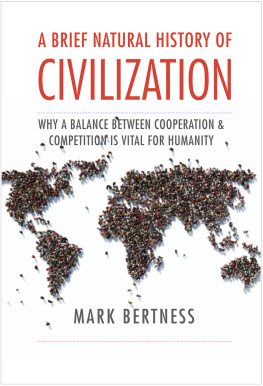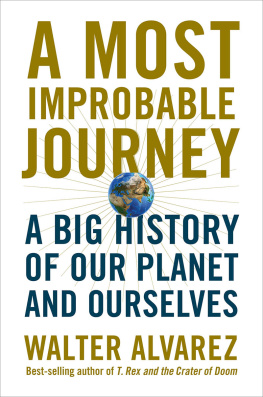CONTENTS
List of Tables
- Chapter 02
- Chapter 07
- Chapter 08
List of Illustrations
- Chapter 01
- Chapter 02
- Chapter 03
- Chapter 04
- Chapter 05
- Chapter 06
- Chapter 07
Guide
Pages
Praise for the first edition
Brilliant. It pushes the project of theorizing big history a lot further, in exactly the right way, alert to the dangers of over-theorizing or theorizing on too limited information. It will be a major contribution to the discipline.
David Christian, Macquarie University, author of Maps of Time: An Introduction to Big History
This book has convinced me not only that Big History is interesting and exciting, but has established a genuine intellectual basis for integrating historical knowledge, and historical method, with those of the natural world. This is a framework in which, ideally, all history should be investigated, taught and discussed.
R. I. Moore, Emeritus Professor of History, Newcastle University
The most exciting book that Ive read in 30 years. A masterpiece!
Barry Rodrigue, University of Southern Maine
Narratives dont come much grander than the current scientific view of the history of the Universe Spier is one of a small band of exponents of big history, the effort to put the whole story together in an academically rigorous way Everyone should have access to this.
Times Higher Education Supplement
To William Hardy McNeill:
The historian I admire the most in the whole wide world.
We remain submerged in a vast evolutionary process that began with the Big Bang (probably) and is heading to an unknown future a system in which matter and energy evolve, stars form and break apart, the solar system took form and will eventually collapse (but not before life does), and human societies emerged on planet Earth, beginning an evolution whose end is not in sight.
(William H. McNeill, The Global Condition (1992), pp. xivxv)
BIG HISTORY AND THE FUTURE OF HUMANITY
SECOND EDITION
FRED SPIER
This edition first published 2015
2015 John Wiley & Sons, Ltd.
Registered Office
John Wiley & Sons, Ltd, The Atrium, Southern Gate, Chichester, West Sussex,
PO19 8SQ, UK
Editorial Offices
350 Main Street, Malden, MA 02148-5020, USA
9600 Garsington Road, Oxford, OX4 2DQ, UK
The Atrium, Southern Gate, Chichester, West Sussex, PO19 8SQ, UK
For details of our global editorial offices, for customer services, and for information about how to apply for permission to reuse the copyright material in this book please see our website at www.wiley.com/wiley-blackwell.
The right of Fred Spier to be identified as the author of this work has been asserted in accordance with the UK Copyright, Designs and Patents Act 1988.
All rights reserved. No part of this publication may be reproduced, stored in a retrieval system, or transmitted, in any form or by any means, electronic, mechanical, photocopying, recording or otherwise, except as permitted by the UK Copyright, Designs and Patents Act 1988, without the prior permission of the publisher.
Wiley also publishes its books in a variety of electronic formats. Some content that appears in print may not be available in electronic books.
Designations used by companies to distinguish their products are often claimed as trademarks. All brand names and product names used in this book are trade names, service marks, trademarks or registered trademarks of their respective owners. The publisher is not associated with any product or vendor mentioned in this book.
Limit of Liability/Disclaimer of Warranty: While the publisher and author have used their best efforts in preparing this book, they make no representations or warranties with respect to the accuracy or completeness of the contents of this book and specifically disclaim any implied warranties of merchantability or fitness for a particular purpose. It is sold on the understanding that the publisher is not engaged in rendering professional services and neither the publisher nor the author shall be liable for damages arising herefrom. If professional advice or other expert assistance is required, the services of a competent professional should be sought.
Library of Congress Cataloging-in-Publication Data
Spier, Fred, 1952
Big history and the future of humanity / Fred Spier. Second edition.
pages cm
Includes bibliographical references and index.
ISBN 978-1-118-88172-9 (paperback)
1.CivilizationPhilosophy.2.HistoryPhilosophy.3.World historyPhilosophy. 4.Human evolution.5.Human ecology.6.Biocomplexity.7.Complexity (Philosophy)I.Title.
CB19.S679 2015
909dc23
2014045124
A catalogue record for this book is available from the British Library.
Cover image: Earthrise, from Apollo 8, 24 December 1968. Photo NASA
For teaching resources and more information about this book, please visit www.bighistory.info.
LIST OF FIGURES
Alexander von Humboldt in his library, Oranienburger Strae 67, Berlin, Germany. Chromolithograph, copy of water-color drawing by Eduard Hildebrandt, 1856 CE . (Original in possession of the author)
energy. (Drawing by Giulia Spier, 2007 CE , then 4 years old)
The variation in the cosmic background radiation provides evidence for the first emergence of greater complexity. (Source: NASA)
The solar system habitable zone, orbits of planets not drawn to scale. (Source: NASA)
are clearly visible, including the shape of the continents and the location of deserts, which contribute to define the Goldilocks circumstances for life. (Source: NASA)
A human effort to recreate the African savanna elsewhere on the planet, Amsterdam, Westerpark, winter 19956 CE . (Photograph by the author)
is going to die; the Cconucuyca family weeding potatoes in January of 1986 CE near the village of Zurite, Anta, Peru. (Photograph by the author)
Religious-political remnant of early state formation? The Temple (literally: Altar) of Heaven, Beijing, China, where Ming and Qing emperors took part in annual ceremonies to procure a good harvest. (Photograph by the author, 2011 CE )
Firth of Forth Railway Bridge near Edinburgh, Scotland, exemplifying the industrial revolution: steel connecting distant shores carrying powered transportation linking the country. (Photograph by the author, 1970 CE )
propel them into lunar orbit and back, fall 1968 CE . (Source: NASA)
LIST OF TEXT BOXES
PREFACE AND ACKNOWLEDGMENTS
The biggest philosophy, foundation-shaking impression was seeing the smallness of the Earth. Even the pictures dont do it justice, because they always have this frame around them. But when you put your eyeball to the window of the spacecraft, you can see essentially half of the universe. Thats a lot more black and a lot more universe than ever comes through a framed picture. Its not how small the Earth was, its just how big everything else was.
(Apollo 8 astronaut William Anders in Chaikin & Kohl (2009), p. 158)
This book is about big history, the approach to history in which the human past is placed within the framework of cosmic history, from the beginning of the universe up until life on Earth today. This book offers a fresh theoretical approach to big history that, I hope, will provide a better understanding not only of the past but also of the major challenges humanity will be facing in the near future.








